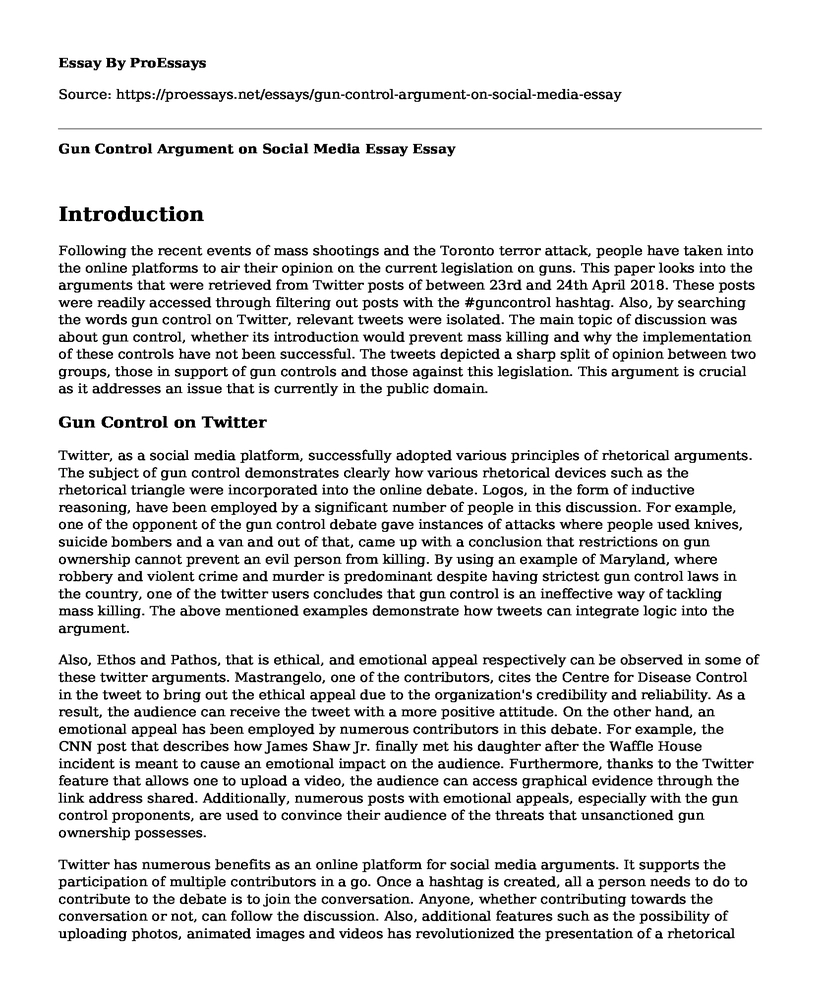Introduction
Following the recent events of mass shootings and the Toronto terror attack, people have taken into the online platforms to air their opinion on the current legislation on guns. This paper looks into the arguments that were retrieved from Twitter posts of between 23rd and 24th April 2018. These posts were readily accessed through filtering out posts with the #guncontrol hashtag. Also, by searching the words gun control on Twitter, relevant tweets were isolated. The main topic of discussion was about gun control, whether its introduction would prevent mass killing and why the implementation of these controls have not been successful. The tweets depicted a sharp split of opinion between two groups, those in support of gun controls and those against this legislation. This argument is crucial as it addresses an issue that is currently in the public domain.
Gun Control on Twitter
Twitter, as a social media platform, successfully adopted various principles of rhetorical arguments. The subject of gun control demonstrates clearly how various rhetorical devices such as the rhetorical triangle were incorporated into the online debate. Logos, in the form of inductive reasoning, have been employed by a significant number of people in this discussion. For example, one of the opponent of the gun control debate gave instances of attacks where people used knives, suicide bombers and a van and out of that, came up with a conclusion that restrictions on gun ownership cannot prevent an evil person from killing. By using an example of Maryland, where robbery and violent crime and murder is predominant despite having strictest gun control laws in the country, one of the twitter users concludes that gun control is an ineffective way of tackling mass killing. The above mentioned examples demonstrate how tweets can integrate logic into the argument.
Also, Ethos and Pathos, that is ethical, and emotional appeal respectively can be observed in some of these twitter arguments. Mastrangelo, one of the contributors, cites the Centre for Disease Control in the tweet to bring out the ethical appeal due to the organization's credibility and reliability. As a result, the audience can receive the tweet with a more positive attitude. On the other hand, an emotional appeal has been employed by numerous contributors in this debate. For example, the CNN post that describes how James Shaw Jr. finally met his daughter after the Waffle House incident is meant to cause an emotional impact on the audience. Furthermore, thanks to the Twitter feature that allows one to upload a video, the audience can access graphical evidence through the link address shared. Additionally, numerous posts with emotional appeals, especially with the gun control proponents, are used to convince their audience of the threats that unsanctioned gun ownership possesses.
Twitter has numerous benefits as an online platform for social media arguments. It supports the participation of multiple contributors in a go. Once a hashtag is created, all a person needs to do to contribute to the debate is to join the conversation. Anyone, whether contributing towards the conversation or not, can follow the discussion. Also, additional features such as the possibility of uploading photos, animated images and videos has revolutionized the presentation of a rhetorical argument. Use of pictures and videos can successfully garner the support of the audience due to the emotions that they possess. Moreover, users can share links that enable individuals to access external sources. Thanks to these advantages, Twitter simplifies arguments and expands the outreach both in terms of the number of contributors and the size of the audience.
In spite of the abovementioned benefits, Twitter discussion faces numerous challenges. First, it is almost impossible to moderate a debate on an online platform. Since individuals can contribute to the debate from any location around the country, maintaining an organized discussion is impossible. There is no order and chronology with which the contributors can comment about the subject. Additionally, the language used cannot be easily sanctioned. Therefore, disagreement and diversion from the main discussion to personal attacks can be witnessed. Moreover, the language use and tone is subject to different interpretations from the audience. It is common for tweets to be misunderstood. Another effect of unorganized discussion is the difficulties it brings in following up a debate. The audience might find it difficult to follow up the rhetorical argument due to lack of chronologies in the organization of ideas by the contributors.
Conclusion
In sum, twitter is a platform that can support a debate successfully. From the report on the argument of gun control on social media, it is clear that various rhetorical devices, especially the rhetorical triangle can be integrated into an online discussion. Opponents and proponents of the Twitter argument in question have employed logos, ethos, and pathos in persuading the audience about their opinion. Benefits such as increased outreach and unique features make the social media platform a suitable place for debating. However, difficulties in moderating such arguments is a challenge. Nonetheless, Twitter has proven to be a possible venue to discuss pressing issues.
Cite this page
Gun Control Argument on Social Media Essay. (2022, Jan 17). Retrieved from https://proessays.net/essays/gun-control-argument-on-social-media-essay
If you are the original author of this essay and no longer wish to have it published on the ProEssays website, please click below to request its removal:
- Crime Decline Genre Analysis
- Criminal Justice Motivation Essay
- Paper Example on Children's Rights
- Essay Sample on International Law and Human Rights
- Essay Sample on Public Courtroom Trials: Cameras in the Courtroom & Impact
- Essay Sample on Civil & Criminal Cases: Comparing Procedures
- Free Essay Example: Facebook's Controversial Privacy Policies and Impact on Emotions







